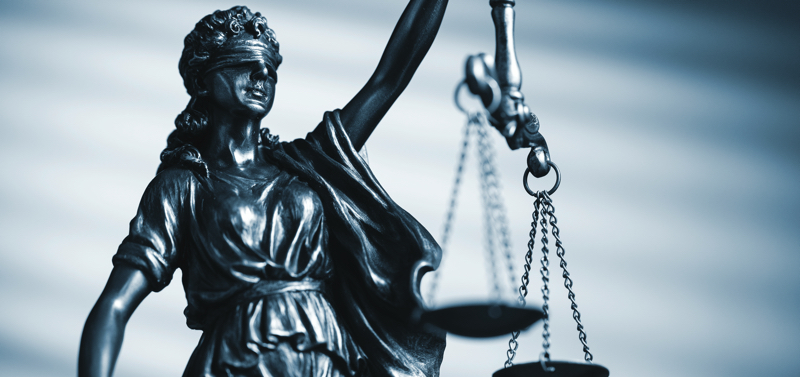
01 Jul JUSTICE CAN BE BLIND

Margaret A.M. Heine
is the principal counsel at Heine Law Group in Fullerton, California. She is licensed in California and Washington and has authority to practice before the Supreme Court of the United States and the United States Court of International Trade.
Her practice includes estate planning, wills, trusts, and probate as well as business, real estate, and civil litigation. Email: nbylegas@gmail.com or visit company website www.margaretamheine.com.
JUSTICE CAN BE BLIND
There is a general belief in the justice system in our country. It may be difficult to see it clearly during these times of civil unrest and anger shouting for change. There are a variety of factors affecting how blind justice is: Bias, Misconduct, and Immunity.
William Penn in Some Fruits of Solitud stated, “Justice is justly represented blind, because she sees no difference in the parties concerned. She has but one scale and weight, for rich and poor, great and small.”
In general, this is what our justice system strives to achieve. We cannot be blind to the fact that the justice system, its tenets and beliefs, needs to realign on occasion and adjust to the societal outcry for change. In doing so, however, the justice system must maintain orderly application of the law and proper punishment for abuse of the law. That is a tough love statement of the needs of justice.
Inequity and unfairly treating the accused in legal matters predates the civil war. In reviewing the history of legal cases determined by the Supreme Court, there are numerous examples of bias influencing juries and prosecutors. The guilt of the criminal being determined by their ethnicity. Before the 1900’s, it was primarily the Irish who were falsely accused and not given a fair trial, then the Italians, the Jews, the Germans, and the Blacks.
Prejudice or injustice against other ethnicities may have been more difficult to identify as most of those falsely accused were racially the same as the jurors in the case. To address the inherent injustice of homogenous juries not necessarily representing the cross section of the populace, the Courts would ultimately decide that juries needed to be comprised of all races and all genders.
The Civil Rights Act of 1875 first gave blacks the right to sit on juries. This Civil Right Act of 1875 was later overturned by the Supreme Court, and it wasn’t until Norris v. Alabama (1935) that the Court said that blacks cannot be excluded from jury service. That didn’t mean that the juries were necessarily composed of “peers”. There were a number of cases in which all black jurors were excluded by the prosecution when the accused was black. This was addressed as late as 1985 in Batson v. Kentucky, when the Court determined that the ends of justice would not be served by allowing prosecutors from keeping all blacks off of a jury for a black defendant.
Women have faced similar biases. Blacks beat women to the jury box by decades. Utah was the first state to fully allow women to serve on juries. In 1898, Utah gave women the right to be jurors or to withdraw if they were needed more at home. It wasn’t until the 1930’s when women were seated more frequently as jurors. Thanks to the 19th Amendment giving women the right to vote in 1920, the Courts started to apply the 6th Amendment and the 14th Amendment to give women a civic right to sit on juries and to allow women defendants an opportunity to have a jury of their peers include other women. However, the states were slow to approve women as jurors, and it wasn’t until 1968 when the last state to hold out, Mississippi, finally gave women the right to be jurors.
The Civil Rights Act of 1871 was passed to protect blacks from the Ku Klux Klan and abuses being committed against persons “of color”. This is embodied in United States Code 42, section 1983.
42 USCS 1983 provides that “Every person who, under color of any statute, ordinance, regulation, custom or usage, … causes … any citizen of the United States … the deprivation of any rights, privileges, or immunities secured by the Constitution and laws, shall be liable to the party injured…”
The courts have interpreted this section to mean that any person, including police officers, prosecutors, or other public officials who misuse their authority can be sued for their actions. In the 1960 case of Monroe v. Pape, the court found that police officers could be sued for their actions against James Monroe, and his entire family, all without a warrant or reason, and lacked authority to harass and arrest Mr. Monroe.
This was viewed as a reasonable means to keep the police and authorities in check, and to have them be responsible for their actions, when they were doing their jobs. This all changed in 1967 when the concept of “qualified immunity” was developed in the case of Pierson v. Ray.
The Court found that police officers should not have to choose between doing their job and the risk of suit for doing their job. The police officers in this case had asked 15 Episcopal priests, 3 of whom were black, to leave the coffee shop at the bus terminal where they were going to have lunch. They refused, which was deemed, “a breach of the peace”, and all were arrested. The police officers, the city and county were not held liable for false imprisonment, false arrest, and false imprisonment.
The concept was then greatly expanded in 1982 with the decision in Harlow v. Fitzgerald. A whistleblower lost their government contract for calling out misuse of funds, misappropriations and cost overruns. They sued the government and then President Nixon. The Court found that the government officials were immune from prosecution as they had immunity. The Court has expanded the role of qualified immunity by setting a standard which is used to this day: that to overcome immunity, you have to establish that a judicial decision exists which contains the same facts and conduct that found the officers or the official would not be shielded and that immunity would not apply.
Next month, more on qualified immunity and its impact on the perception of justice.
In very improvement in our conceptions of justice, as well as in the machinery for the administration of justice, whereby a closer approximation to exact justice may be secured, will make for social peace, though the mere adjudication of conflicting interests will not remove the conflicts themselves nor their cause. That lies deeper than legislatures or courts can probe.
THOMAS NIXON CARVER, Essays in Social Justice




Sorry, the comment form is closed at this time.